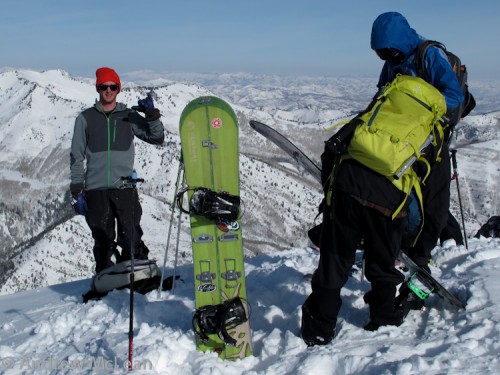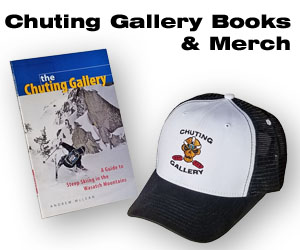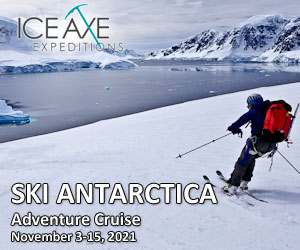Utah Snow & Avalanche Workshop – Nov 3rd
The Utah Avalanche Center is hosting its 4th annual snow & avalanche workshop this upcoming weekend and given how dicey last year was, there should be some good fodder for discussion. The workshop starts with a brief description of what made the conditions so dangerous and then goes into individual accident scenarios including the infamous Taylor Mountain slide in Wyoming and the tragic accident on Kessler in Utah. Jake Hutchinson will be talking about the overload of avalanche information that’s available, followed by a discussion on backcountry litigation issues, and then a roundtable discussion with various Department of Transportation people in regard to popular roadside skiing.

On top of Kessler with Alecs Barton just a few moments before his 2012 accident.
The cost is $26 and it begins at 1:00pm and then finishes with a social hour from 5:30 to 6:30. It is at the South Towne Exposition Center, which means I’ll have to break my pledge to avoid complexes ending with an un-American “e” (towne, pointe, centre, etc.) but it will be worth it for this event.
Directions and online ticket purchase here
I’m looking forward to the Taylor Mountain discussion because it not only brings up avalanche issues, but also the growing social issues of what happens when more and more people start going into the backcountry. Should there be rules? Should some areas be off-limits to beginners, or in the case of Taylor Mountain, supposed experts? Who is responsible for who? I’ve spent hour discussing this incident with avy-savvy people and it always bring up interesting comments.
________________________________
Help support StraightChuter.com and search through the debris with a Pieps DSP Tour Avalanche Beacon from Backcountry.com. Click on the photo below…
Category: Announcements










Andrew,
love to go, but that’d be my wife’s birthday, but I think there’s definitely a need for better communication between different touring parties as to when someone consents to being dropped in on from above. And it could easily be found to be negligence in court to do so.
I’m thinking a party above could raise their hand to a visible party below to ask if it’s OK for them to ride, and a party below would hold both hands up in a stop and wait sign if the answer is no. Alternatively, the party below could make circles with one arm (the rounding 3rd base sign) to consent to someone dropping in while they are on the skin track off to the side or not. Maybe developing a few standards requiring parties to communicate could keep people from dropping in on others and keep litigation and multiple burials out of the bc.
Also, say my partner and I drop main Days, Crystal or East pass, etc., we should probably have made an effort or waited to talk to a party behind us as to how long to wait to allow us time to skin up and clear out from the bottom and maybe there should be a 10 minute custom established between different touring groups in blind run out zones in the riding community.
Thanks for the note Dave. It brings up lots of interesting questions.
– Do the people below bear no responsibility for themselves?
– Why would anybody bother to break trail if they then had to wait for the entire slope below to be clear, which could be a matter of hours?
– Would the negligence charge apply to newcomers who were completely ignorant of backcountry protocol, or only those who should know better?
– What if the upper skier triggers a slide that propagates to an entire drainage (as with Taylor)? When do you draw the line as to what “skiing above” someone means?
And many more.
With confined couloir skiing, I’ve found it very common to break trail for thousands of feet, only to look back and see a group, or groups, following my track far below. Waiting for them could involve hours, and once they get there, what if another group(s) are following them? Are you supposed to ask the second party to wait as well? By asserting yourself and being authoritarian are you setting yourself up for even bigger legal issues, ie. “he made me wait for an hour during which time the slope warmed up and became dangerous?” Are you responsible for all parties in your drainage and vice versa? Are you responsible if you honestly didn’t see a party below you? How about if you willingly didn’t see a party below you?
The short answer to all of this is to avoid skiing around other parties, which in crowded areas is close to impossible. It’s an interesting social question as much as an avalanche or protocol issue.
You’re right it does get very complicated very quickly, especially as to where you draw the lines. I can see how by joining a group of people lapping Cardiac ridge or silver fork type of places that you may be agreeing to have people ski pretty close to above you. Socially it seems most folks will wait for a person to cross from directly under them and only drop in when that person is off to the side a bit (cardiac ridge for example. But it is impossible to really draw a line. The problem with negligence is anyone sued for taking out another would probably be held negligent because it would be easy to find an expert who will say that any reasonable tourer is going to be aware of the potential to cause a slide and bury a person below you or on a connected slope and that reasonable safe behavior is to only have one person on a slope at a time. The avalanche books and expert advice is pretty clear on that, so I’d say that the reasonable touring standard is pretty set in the regard of establishing negligence. If you own a transceiver it’d be hard to say you didn’t or should’t have known this. the other argument of course would be well, this slope has slid wall to wall before and avys will jump over separating features, but since the usual slides here are like this and stop here and there, it was reasonable to ski when the person below was at spot X. It’s a good discussion to have out there in the community and may have to be spot specific. Is there a protocol for the Y couloir or does everyone just barge up irregardless these days?
On your first and second point, I’d venture that anyone who follows a skin path or breaks trail up an avalanche path where they can not be sure that they can be seen at all times from above has to have assumed the risk that someone above may ski down on top of them just as they have assumed the risk that a natural may clean them out. Does that mean in your case that you should not look back on your way up, it’s callous-but something to think about in your first statement to a third party.
I pretty much assume that tourers will be reckless and disrespectful and drop right on to me, so personally I prefer to avoid other parties and keep moving instead of lapping a feature. What’s the use of being right if you are dead. That said, maybe no one in their right minds should tour up from the bottom of a run like Main Days unless they are fine with being skied over because they won’t be seen.
Maybe the important ground to cover is where people can agree: Permission to ski above should be asked when it can be asked, and it should not be assumed. Maybe standard hand signals could help. Plenty of time should be given between two different touring groups on runs that end out of sight from the starting point. I don’t know how you would set a standard for someplace like cardiac ridge where people pile up and run in a big circle. It would seem that you are consenting to the practice of being skied over or alongside, by being there, because it’s normal practice over there, but it seems an impossible line to draw and that might not how the chips might fall if a lost one’s relatives don’t see it that way.
In the Taylor mountain case, you had a single “expert” skiing on top of a group of multiple “experts.” The crux is assuming avalanches can be predicted with 100% accuracy, and not only when they will occur, but what will trigger them and how widespread they will be. I also think a double standard is being implied – if you are a clueless newbie, it is tragic accident, but if you have taken the time to get educated and experienced, it is a criminal offense.
thanks for the discussion, interesting changes to the near city backcountry in the last 10-15 years for sure. I think though that the degree of expertise is not so much a factor when you are talking about potential legal liability. If you have gotten yourself to the top of a big slope and you are a complete idiot, I think it would become difficult to prove you didn’t know you were potentially endangering those below you.
There is a degree of knowledge to which the reasonable person who climbs mtns. in the snow to slide down them will be held to and it would not be the same standard that a taxi driver from tampa would be held to. Even if you are completely clueless, you would not be off the hook for your action if you should have known but claim “to not to” as Mater would say. I don’t think there is a double standard ther, I think pretty much everyone would be held to enough of a standard that they couldn’t claim ignorance/no liability.
So why would anybody ever break trail and knowingly be above others?
1. to beat them to it
2. sometimes you can’t avoid it
3. I guess that’s the part of the game: do you ride back the way you came to ride it first after the people following you catch up or at least get out of the way, or do you ride the backside and let those following you have it with your track put in.
4. If it’s a chute, I would guess a proper scolding would be in order for those following below when there are no exit tracks.
5. Maybe establishing a protocol is somewhat unrealistic with how unique each mountain feature is.
#5
Eh…This is exactly why I hate BC skiing in crowded, hip spots. I avoid it. Plain and simple. Go to thoes types of areas and assume a different level of unknown risk. Plain and simple.
I think smokey nailed it. In popular areas there is and always will be an unavoidable risk associated with other skiers. To try and manage that is each users task and not something that can or should be ‘regulated’ with unwritten rules.
This wild west feeling is partly why we ski away from the areas.
Although I do think drop in etiquette is something that should be included in any modern level 1 avy course.